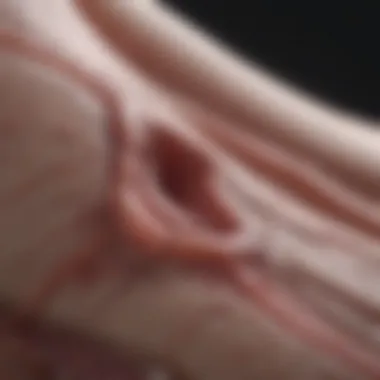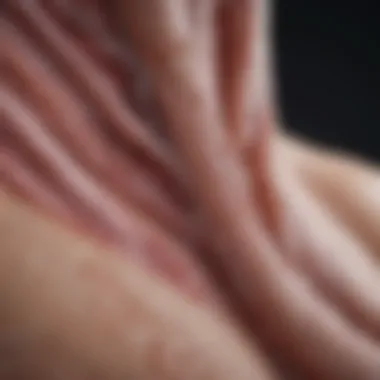Transrectal Ultrasound: Comprehensive Overview


Intro
Transrectal ultrasound (TRUS) emerges as a crucial tool, particularly in the realm of urology. Its utility spans various diagnostic needs, ranging from assessing prostate conditions to aiding in biopsies. By utilizing sound waves to create images, TRUS provides real-time visualization of the rectal and surrounding structures. This technique allows physicians to make informed decisions about patient management and treatment options.
In the following sections, we will explore the fundamental aspects of TRUS, detailing its applications, technologies, advantages, and limitations. An examination of recent advancements in this field will highlight how improvements continue to shape patient care. The intention is to create a comprehensive understanding of TRUS for students, researchers, educators, and healthcare professionals alike.
Prelims to Transrectal Ultrasound
Transrectal ultrasound (TRUS) has become an essential procedure in urology and gastroenterology. It serves as a vital tool not only in diagnosis but also in the guidance of therapeutic interventions. With advancements in medical imaging, TRUS facilitates improved patient outcomes and accurate assessments of various conditions. This section will cover the significance of TRUS, emphasizing its relevance in the clinical setting.
Overview of Ultrasound Technology
Ultrasound technology utilizes high-frequency sound waves to create images of internal structures. A transducer emits these sound waves, which bounce off tissues and return to the device, forming visual representations of organs and abnormalities. TRUS is particularly effective for imaging organs located in the pelvic region, such as the prostate and rectum.
The non-invasive nature of ultrasound makes TRUS a preferred option for many physicians. Enhanced imaging capabilities offer real-time feedback, allowing for precise diagnostic evaluations. Moreover, the technology continues to evolve, introducing higher resolution imaging and newer techniques that increase accuracy. These advancements underscore the importance of ultrasound technology in modern medicine, promoting patient safety and effectiveness.
History and Evolution of TRUS
The development of transrectal ultrasound began in the late 20th century. Initially introduced in the 1980s, it provided clinicians with a novel approach to assess the prostate and surrounding structures. Early models faced limitations with image quality and resolution, constraining their diagnostic utility.
Over the years, persistent research and technological improvements have led to significant enhancements in TRUS. The introduction of higher frequency transducers paved the way for clearer images and more precise diagnostic capabilities. Additionally, innovations such as 3D ultrasound have further transformed the landscape, allowing for detailed anatomical evaluation.
As medical professionals recognized the utility of TRUS, its applications expanded beyond prostate examinations. It now plays a critical role in various procedures, such as biopsies and the assessment of rectal disorders, establishing itself as an indispensable aspect of clinical practice.
"Transrectal ultrasound is a pivotal tool in diagnosing prostate conditions, highlighting its importance for urologists and patients alike."
Clinical Applications of TRUS
Transrectal ultrasound (TRUS) plays a pivotal role in modern urological practice. It offers a non-invasive method to visualize pelvic organs, particularly the prostate and surrounding areas. The meticulous application of TRUS in clinical settings is significant, as it enhances diagnostic accuracy and guides treatment decisions. Understanding the clinical applications of TRUS underscores its value as a fundamental tool for practitioners and patients alike.
Prostate Examination and Diagnosis
One of the most prominent uses of TRUS is in the examination and diagnosis of prostate conditions. The procedure allows for detailed imaging of the prostate gland, helping detect abnormalities that may indicate prostate cancer or benign prostatic hyperplasia. During TRUS, high-frequency sound waves create a clear image of the prostate, which can reveal lesions or any irregularities in its structure. The ability to visualize the organ in real time aids in assessing its size and shape, critical factors in diagnosis.
Additionally, TRUS can be utilized to assess prostate volume, which is crucial for making informed decisions about treatment options. The importance of early detection cannot be overstated. Clinically, patients who undergo TRUS have a higher chance of catching malignancies at earlier stages, significantly affecting treatment outcomes. TRUS contributes to personalized care through targeted diagnostics and facilitates timely interventions.
Guidance for Biopsy Procedures
TRUS is essentiel for guiding biopsy procedures in cases where prostate cancer is suspected. The technique allows urologists to precisely locate areas of interest for biopsy. By integrating real-time imaging, the accuracy of needle placement is greatly improved, reducing the likelihood of complications and false-negative results. This is particularly important, as prostate cancer can often go undetected if biopsies are not accurately positioned.
During a transrectal ultrasound-guided biopsy, clinicians can obtain tissue samples from targeted areas, ensuring that the most relevant portions of the prostate are assessed. This targeted approach raises the diagnostic yield and improves the overall effectiveness of the biopsy. Studies have shown that TRUS-guided biopsies result in smoother procedures and higher rates of cancer detection compared to blind biopsies.
Assessment of Rectal Disorders
Beyond prostate examination, TRUS is valuable in evaluating various rectal disorders. This includes conditions such as rectal cancer, inflammatory bowel disease, and anal fistulas. The procedure allows for thorough examination of the rectal wall and surrounding structures, offering insights that are critical for establishing diagnoses and treatment plans.


For example, TRUS can accurately determine the extent of rectal cancer invasion, which is essential for staging and planning surgical approaches. Furthermore, assessment of anal fistulas with TRUS can help visualize the relationship between the fistula tract and anal sphincter, guiding surgical management. The non-invasive nature of TRUS makes it an ideal option for these evaluations, minimizing discomfort for patients while providing reliable results.
"Transrectal ultrasound not only enhances diagnostic accuracy but also significantly improves patient management strategies in urology."
In summary, the clinical applications of TRUS are vast and impactful. By facilitating diagnosis and guiding treatment processes, TRUS has become an invaluable tool in the management of urological and rectal health.
The TRUS Procedure
The transrectal ultrasound (TRUS) procedure is a critical component in the application of ultrasound technology for medical diagnostics. Understanding this procedure is essential for both healthcare professionals and patients, as it significantly influences diagnosis and subsequent management strategies. TRUS serves mainly in urology, particularly in prostate examinations, and offers several benefits over alternative methods. For instance, this procedure can provide real-time imaging with high precision, which is pivotal when assessing abnormalities in the prostate or rectum.
Preparation for TRUS Examination
Preparation for a TRUS examination involves several important steps to ensure patient comfort and procedural success. Education plays a vital role in this phase. Patients need to understand what to expect, which can reduce anxiety and enhance cooperation during the ultrasound. Typically, patients are advised to follow specific preparation guidelines:
- Dietary restrictions may be suggested. Usually, avoiding solid food for a few hours before the procedure can minimize discomfort.
- Fluid intake is essential. Patients are often recommended to drink a certain amount of water before the exam, which helps in adequately filling the bladder. A full bladder enhances visualization of the prostate.
- Bowel preparation can be necessary for some patients, as emptying the rectum can provide better access and visualization during the procedure.
Following these preparation steps is crucial for obtaining the best possible results from the TRUS examination.
Conducting the Ultrasound Exam
Conducting the TRUS exam itself requires a skilled technician or physician who is trained in the operation of ultrasound equipment. The process typically unfolds in a controlled environment, such as a clinic or hospital. The actual procedure includes notable steps:
- Positioning the Patient: The patient is usually asked to lie in a comfortable position, often on their left side. This position allows easier access to the rectal area.
- Insertion of the Transducer: A lubricated transrectal ultrasound probe is gently inserted into the rectum. The probe emits sound waves that create images of the prostate gland and surrounding tissues.
- Image Acquisition: The provider will manipulate the probe to capture images from multiple angles. This can take several minutes and is crucial for gathering detailed information about the prostate's structure and any abnormalities.
It's important to note that during the ultrasound, patients may experience some discomfort or pressure, but severe pain is not typical. Continuous communication between the patient and the clinician can help alleviate concerns during the process.
Post-Procedure Observations
After the TRUS examination, some important observations and care steps need to be considered:
- Monitoring for Immediate Reactions: Following the procedure, the medical team will watch for any immediate adverse reactions, such as bleeding or severe pain.
- Patient Instructions: Patients are often given specific instructions to follow post-exam, including dietary recommendations and activities to avoid, such as heavy lifting or straining.
- Results Discussion: Within a few days, the clinician will discuss the imaging results with the patient. These findings can lead to further diagnostic steps or treatment plans.
In summary, the TRUS procedure is a multi-step process requiring careful preparation, precise execution, and thorough post-procedure follow-up. Each phase is vital in ensuring accurate diagnosis and optimal patient care.
Advantages of TRUS
Transrectal ultrasound (TRUS) serves as a critical tool in the medical field, particularly in urology. Its advantages contribute significantly to its widespread use and the trust placed in it by both healthcare providers and patients. The non-invasive nature of TRUS, coupled with its real-time imaging capabilities and enhanced diagnostic accuracy, positions it as a go-to solution for various clinical scenarios. Understanding these advantages is essential for medical professionals in order to optimize patient outcomes and make informed treatment decisions.
Non-Invasiveness of the Procedure
One of the foremost advantages of TRUS is its non-invasive nature. Unlike more invasive procedures that require surgical intervention, TRUS offers a way to gather essential diagnostic information without significant patient discomfort. The transducer, which emits sound waves, is inserted into the rectum but does not penetrate deeply into the body. This aspect minimizes trauma and risk of infection, making it a safer option for patients.
The lower risk of complications is particularly beneficial for vulnerable populations, such as the elderly or those with existing health issues. This non-invasive approach allows clinicians to perform necessary evaluations without subjecting patients to the potential side effects of traditional invasive methods.
Real-Time Imaging Capabilities
Another notable feature of TRUS is its real-time imaging capabilities. This technology enables immediate visualization of anatomical structures, allowing for instantaneous assessments during the procedure. As the ultrasound generates images, clinicians can view the prostate and surrounding tissues dynamically, which enhances the ability to identify abnormalities as they occur.


This real-time feedback is instrumental, especially during biopsy procedures where precise localization is paramount. Clinicians can adjust their approach based on live findings, improving the accuracy of biopsies and other interventions. Moreover, the ability to visualize changes in real time provides a more comprehensive understanding of the patient's condition, facilitating better clinical decisions and follow-up care.
Enhanced Diagnostic Accuracy
Lastly, TRUS significantly contributes to enhanced diagnostic accuracy. The high-resolution images produced by ultrasound technology allow for detailed examination of the prostate, identifying size, shape, and any pathological changes. This clarity aids in differentiating between benign and malignant conditions effectively.
With advanced software and imaging techniques, TRUS can highlight subtle differences often missed by other imaging modalities. For instance, detecting early signs of cancer or assessing the severity of prostate enlargement can directly impact treatment choices. By integrating TRUS data with other diagnostic information, healthcare professionals can formulate tailored treatment strategies, ultimately leading to improved patient management and outcomes.
"Enhanced diagnostic accuracy provided by TRUS plays a vital role in guiding treatment modalities and ensuring that patients receive appropriate care."
In summary, the advantages of TRUS encompass its non-invasive nature, real-time imaging capabilities, and enhanced diagnostic accuracy. These elements combine to create a powerful diagnostic tool that improves patient care and outcomes in various clinical contexts.
Limitations and Challenges of TRUS
Transrectal ultrasound (TRUS) offers significant diagnostic benefits, but it is not without limitations and challenges. Understanding these aspects is crucial in ensuring optimal patient care and enhancing the overall clinical utility of the procedure. The drawbacks of TRUS can impact patient experience, the accuracy of results, and the interpretation of imaging data. Recognizing these factors can improve how health professionals approach TRUS in various clinical contexts.
Patient Discomfort and Risk Factors
One of the primary concerns associated with TRUS is patient discomfort. The procedure involves the insertion of a transducer into the rectum, which can cause anxiety and physical discomfort for patients. Some might experience pain or soreness during and after the procedure. This discomfort can lead to an overall negative perception of the procedure, potentially discouraging patients from pursuing necessary examinations in the future.
Additionally, there are several risk factors to consider when performing TRUS. Patients who have recent rectal surgeries, active infections, or severe hemorrhoids may face heightened risks. Health professionals must carefully evaluate the patient's medical history and assess the potential risks before proceeding with the examination. Given these concerns, strategies to minimize discomfort, such as using the smallest possible transducers and ensuring proper positioning, can significantly improve the patient experience.
Technological Constraints
Despite advancements in ultrasound technology, some constraints still limit the efficacy of TRUS. One notable barrier is related to the imaging quality. Artifacts or limitations in resolution can hinder the visualization of certain structures. In cases where the prostate is anatomically challenging or has a complex structure, TRUS may not provide the clarity needed for accurate diagnoses.
Moreover, the operator's expertise plays a critical role in the quality of imaging results. Variability in skill levels among ultrasound technicians can lead to inconsistencies in the outcomes. Technological advancements may mitigate some of these issues, yet disparities persist. It is vital that healthcare providers continue to invest in training and improve their skills to optimize the use of TRUS as a diagnostic tool.
Interpretation of Results
The interpretation of TRUS results is another area that presents challenges. Although TRUS provides real-time images, interpreting these images accurately requires significant experience and knowledge. In some instances, findings may be ambiguous, leading to difficulties in making definitive diagnoses. Misinterpretations can result in unnecessary follow-up procedures or, conversely, missed opportunities for treatment.
Furthermore, the subjective nature of ultrasound interpretation can vary among different radiologists or urologists, leading to inconsistencies in clinical decisions. This subjectivity reinforces the need for a multidisciplinary approach in managing TRUS findings. Secure collaborating with other specialists can enhance the diagnostic accuracy of TRUS and ensure a comprehensive treatment plan is developed for patients.
Understanding the limitations of TRUS is essential for improving the overall effectiveness of this diagnostic tool in clinical practice. By being aware of patient discomfort, technological constraints, and the challenges in result interpretation, healthcare providers can better navigate the complexities of the TRUS process for optimal patient outcomes.
Technological Advancements in TRUS
Advancements in transrectal ultrasound technology have profoundly impacted its clinical application. These innovations have improved both the accuracy and efficiency of the procedure, making TRUS an even more vital tool in modern diagnostic practices. The key developments in imaging techniques, integration with other modalities, and future innovations are critical aspects that professionals should understand. Current technology enhances the overall patient experience and diagnostic capabilities.
High-Resolution Imaging Techniques
The implementation of high-resolution imaging techniques has transformed the field of transrectal ultrasound. Higher resolution allows for better visualization of the prostate and surrounding tissues. This clarity leads to improved detection rates of abnormalities, such as tumors or lesions. The enhanced detail helps medical experts make more accurate assessments and treatment decisions.
Moreover, high-resolution imaging supports better monitoring of disease progression over time. Clinicians can observe small changes in the anatomy that may signify a shift in the patient's condition. Higher resolution also aids in the precision of biopsies, minimizing the risks associated with this procedure. By ensuring that the imaging quality is optimal, healthcare providers can bolster patient outcomes significantly.


Integration with MRI Imaging
Combining transrectal ultrasound with MRI imaging represents a significant leap in diagnostic accuracy. This integration allows for a more comprehensive assessment of prostate conditions. MRI provides detailed images of soft tissues, while TRUS offers real-time imaging capabilities. Together, they create a robust diagnostic framework.
This multimodal approach enhances the ability to identify malignant lesions that might be missed by ultrasound alone. The use of MRI information can guide ultrasound probe placement during biopsies, thereby improving the precision of sample acquisition. As a result, patients receive more accurate diagnoses and tailored treatment strategies.
Future Innovations in Ultrasound Technology
Looking ahead, several promising innovations are raising the potential for transrectal ultrasound. Research into advanced imaging algorithms is underway. These technologies aim to automate processes, ultimately improving workflow efficiency. Automated systems could analyze images faster, give real-time feedback to clinicians, and reduce the margin for human error.
Additionally, developments in artificial intelligence could refine diagnostic capabilities. Algorithms trained on vast datasets can assist in identifying patterns and abnormalities unseen by the human eye. This shift may significantly enhance the decision-making process for clinicians.
Impact of TRUS on Patient Management
Transrectal ultrasound (TRUS) plays a vital role in patient management. As a non-invasive imaging method, it provides critical information that influences clinical decision-making, treatment planning, and ongoing patient care. The precision of TRUS imaging enhances the capacity of healthcare professionals to make informed choices based on detailed visual data.
Guiding Treatment Decisions
TRUS significantly impacts treatment decisions across various urological conditions, particularly in prostate cancer management. The detailed imaging assists doctors in staging tumors accurately. Staging is essential as it affects treatment options like radiotherapy, surgical interventions, or active surveillance. Doctors can identify the tumor size and the extent of its spread, thereby allowing targeted approaches for each individual patient.
Moreover, TRUS can help determine the appropriateness of certain therapeutic strategies like hormone therapy. Information gained from ultrasound images allows healthcare providers to tailor their recommendations based on the specific characteristics of the malignancy. This personalized approach could result in better outcomes, ultimately benefiting patients in terms of recovery and quality of life.
Influence on Surgical Approaches
The integration of TRUS into surgical planning is noteworthy. Surgeons rely on TRUS during procedures, especially prostatectomies. Its real-time imaging capability enables surgeons to visualize structures clearly, making it easier to avoid damage to surrounding healthy tissues. This reduction in local complications is crucial in enhancing postoperative recovery and minimizing adverse effects.
In addition, TRUS assists in marking biopsy locations precisely. This accuracy can improve the efficiency of cancer detection in biopsies while reducing the number of necessary biopsies. For conditions such as benign prostatic hyperplasia, using TRUS helps doctors achieve more focused interventions, ensuring that the procedures are less invasive and more effective.
Long-Term Monitoring of Patients
The ongoing use of TRUS in long-term patient monitoring is another key aspect. After initial treatment for prostate cancer, continuous assessments through TRUS can detect any changes or recurrences swiftly. This is vital for adjusting treatment plans if necessary, thus maintaining optimal patient outcomes. Regular imaging allows for a proactive approach, ensuring timely intervention before the disease advances.
Additionally, TRUS can help assess other chronic conditions affecting patients over time. Regular check-ups utilizing this technology contribute to the overall management and adjustment of treatment strategies as patient conditions evolve.
Effective patient management relies heavily on the insights gained from TRUS, underscoring its role as an essential diagnostic tool in modern medicine.
The End
The conclusion section of this article encapsulates essential reflections on transrectal ultrasound (TRUS) and its pivotal role in contemporary medical diagnostics. It synthesizes the insights gathered from various sections, re-emphasizing the advantages and clinical implementations along with future potential. The importance of TRUS cannot be understated, especially given its increasingly integral role in urology and allied health fields.
Summary of Key Insights
In this comprehensive overview, we identified several critical points regarding transrectal ultrasound. Some of the notable insights include:
- Diagnostic Versatility: TRUS serves as a non-invasive technique providing crucial imaging data on prostate conditions, rectal disorders, and more. This asset is particularly significant in early diagnosis and treatment planning.
- Streamlined Procedures: TRUS guides biopsy procedures, improving the accuracy of tissue sampling and decreasing complications related to blind biopsies.
- Technological Advancements: Innovations in imaging technology have facilitated clearer images, thus enhancing diagnostic precision. Recent collaborations with MRI are widening the scope for improved assessments.
- Impact on Patient Management: Insights gained from TRUS inform treatment strategies, influencing decisions ranging from active surveillance to interventional procedures, and even long-term monitoring.
The Future of TRUS in Clinical Practice
Looking ahead, the future of transrectal ultrasound in clinical practice appears promising. Continued advancements may include:
- Artificial Intelligence Integration: AI-based analysis may enable better interpretation of ultrasound images, facilitating quicker diagnoses.
- Miniaturized Equipment: Improved device portability may enhance access for outpatient procedures and broaden the range of professionals who can effectively perform these examinations.
- Enhanced Training Programs: As TRUS technology evolves, so will the need for improved educational frameworks in medical training, ensuring that new generations of clinicians are well-equipped to utilize TRUS effectively.
- Research and Development Focus: Ongoing investments in R&D are vital, emphasizing the development of proprietary algorithms and techniques that further refine the capabilities of TRUS.
Ultimately, the sustained relevance of TRUS hinges on its adaptability to new clinical demands and its integration into broader healthcare protocols. As the medical landscape shifts, TRUS will continue to play an essential role in diagnostics and treatment decisions, underscoring its significance in patient care.







